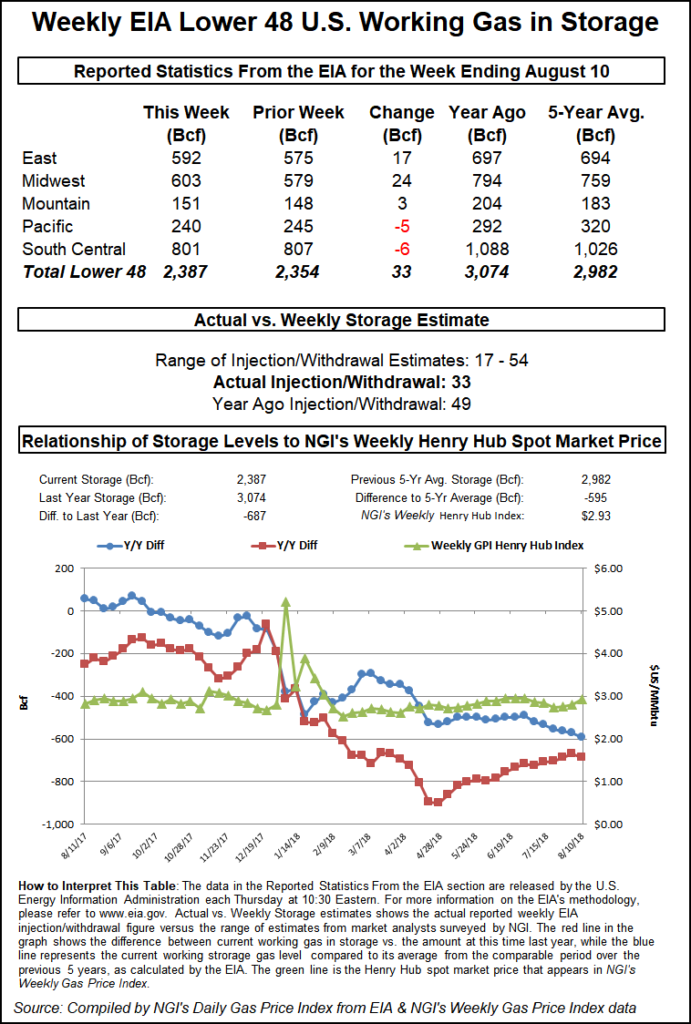September Natural Gas Slips Slips Below $2.90 on Bearish EIA Report
The Energy Information Administration (EIA) reported a 33 Bcf build into storage inventories for the week ending Aug. 10. The reported build was slightly higher than most estimates that pointed to a build in the high 20 Bcf range, but was within the broader range of expectations.

The Nymex September gas futures contract, which traded at $2.939 at Thursday’s market open and held relatively steady ahead of the storage report, immediately fell to $2.909 after the EIA print hit the screen. Just before 11 a.m. ET, the prompt month had fallen to $2.898, down 4.2 cents from Wednesday’s settle.
“This was the first miss to the high side in five weeks, but was essentially in line with expectations as we saw slight upside risks and were generally bearish headed into the print given stronger wind generation and looser burns early in the gas week,” Bespoke Weather Services said.
Despite the immediate pullback in the September contract, storage concerns are the main bullish factor, with cash prices still strong as well, Bespoke said. Additionally, power burns on Wednesday and Thursday continued to run quite tight, “but production sits near highs too. This number should also ease some storage concerns and strengthen resistance around $2.92, with $2.85 in play off any further loosening,” Bespoke chief meteorologist Jacob Meisel said.
Broken down by region, the East injected 17 Bcf into gas stocks, while the Midwest boosted inventories by 24 Bcf and the Mountain region injected 3 Bcf. The South Central posted a 6 Bcf withdrawal, while the Pacific pulled 5 Bcf out of storage.
Inventories as of Aug. 10 stood at 2,387 Bcf, which is 687 Bcf below year-ago levels and 595 Bcf below the five-year average. The deficit to the year-ago level increased by 16 Bcf, while the deficit to the five-year average grew by 23 Bcf.
Estimates ahead of the 10:30 a.m. ET release were wide ranging. A Bloomberg survey of 17 market participants had a range of 17 Bcf to 54 Bcf, with both the average and median pointing to a 29 Bcf injection. A Reuters poll of 20 market participants pointed to an average build of 31 Bcf, with estimates ranging from 24 Bcf to 38 Bcf. Bespoke projected a 31 Bcf build, while Kyle Cooper of IAF Advisors estimated a build of 28 Bcf. Intercontinental Exchange settled at 28 Bcf.
During the similar period last year, 49 Bcf was injected into storage, while the five-year average injection stands at 56 Bcf.
Genscape Inc. senior natural gas analyst Rick Margolin said his firm was expecting a 30 Bcf build. Even though that would come in well below the year-ago and five-year-average figures, “it is actually loose to the five-year when accounting for degree days and normal seasonality,” he said.
Genscape’s Spring Rock daily production estimate for the report week averaged 80.3 Bcf/d, 0.17 Bcf/d higher week/week (w/w) on the strength of gains in the Northeast, Permian Basin and Haynesville Shale, according to Margolin.
Total demand for the report week was an estimated 80.5 Bcf/d, including an average 38.3 Bcf/d of gas burns, according to Genscape’s proprietary estimate, nearly 2.7 Bcf/d higher w/w “and this summer’s second strongest weekly average,” Margolin said.
While inventory storage deficits increased with this week’s report, “our estimates for the current and upcoming gas weeks show relatively stronger injection numbers on the back of notably milder temperatures scrubbing cooling demand loads and exports to Mexico, along with already-observable upticks in Lower 48 production,” he said.
EIA said Thursday it will publish estimates based on a new sample selected for the Weekly Natural Gas Storage Report (WNGSR) beginning Sept. 13. On Sept. 10, EIA plans to revise estimates for the eight weeks covering July 13-Aug. 31 to gradually phase in the estimates from the new sample.
Although the established sampling and estimation methodologies for the WNGSR have not changed, estimates produced from the sample are to reflect the most recent version of the EIA-912 form, which requires storage operators in the South Central region to separately report the volume of working natural gas held in salt facilities and nonsalt facilities, EIA said.
© 2024 Natural Gas Intelligence. All rights reserved.
ISSN © 1532-1231 | ISSN © 2577-9877 |
